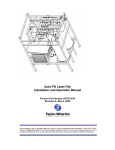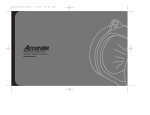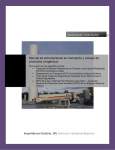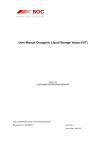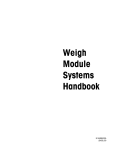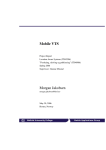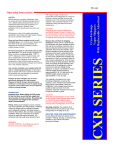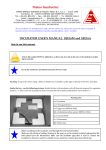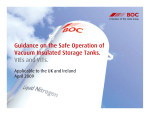Download Express fill 1500 Installation and Operation Manual
Transcript
BT-481 REV. B Express fill 1500 Installation and Operation Manual Do not attempt to use or maintain these units until you read and understand these instructions. Refer to the TaylorWharton’s Safety First booklet (TW-202) for handling cryogenic material. Do not permit untrained persons to use or maintain this equipment. If you do not understand these instructions, contact your supplier for additional information. BT-481 REV. B Table of Contents WARNING Safety Precautions for Liquid Oxygen Safety Precautions for Liquid Nitrogen Safety Precautions for Liquid Carbon Dioxide Safety Precautions for Liquid Nitrous Oxide INTRODUCTION System Description Specifications PIPING CIRCUITS Fill and Vent Circuits Express Fill Circuit Pressure Building Circuit Internal Vaporizer, External Vaporizer Inlet, and Economizer Safety Devices Instrumentation Circuits INSTALLATION Receiving Inspection Handling Vessel Installation Guidelines Fill Box Installation Guidelines OPERATION Filling by Pressure Transfer Filling by Pump Transfer Withdrawing Product Withdrawing Liquid Changing Gas Service MAINTENANCE Leak Test Globe Valves Regulators Instruments Vacuum Trouble-Remedy Guide Replacement Parts APPENDIXES Appendix 1 – Express fill 1500 General Arrangement 3 3 4 4 5 6 6 7 8 9 9 10 13 14 15 16 16 16 16 16 19 19 19 20 20 20 21 21 21 22 23 23 24 25 26 26 BT-481 REV. B WARNING The following safety precautions are for your protection. Before installing, operating, or maintaining this unit read and follow all safety precautions in this section and in the reference publications. Failure to observe all safety precautions can result in property damage, personal injury, or possibly death. It is the responsibility of the purchaser of this equipment to adequately warn the user of the precautions and safe practices for the use of this equipment and the cryogenic fluid stored in it. CAUTION: When installing field fabricated piping, make certain a suitable safety valve is installed in each section of piping between shut-off valves. For more detailed information concerning safety precautions and safe practices to be observed when handling cryogenic liquids consult CGA pamphlet P-12 "Handling Cryogenic Liquids" available from the Compressed Gas Association, 1235 Jefferson Davis Highway, Arlington, VA 22202. Safety Precautions for Liquid Oxygen Oxygen is a colorless, odorless, and tasteless gas that can be condensed into a liquid at the low temperature of 297 degrees below zero Fahrenheit (-183°C) under normal atmospheric pressure. Approximately one-fifth of normal air is oxygen. As a liquid, oxygen is pale blue in color. Oxygen is non-flammable; however it vigorously accelerates the burning of combustible materials. Keep Combustibles Away from Oxygen and Eliminate Ignition Sources Many substances that do not normally burn in air require only a slight spark or moderate heat to set them aflame in the presence of concentrated oxygen. Other substances, which are only moderately combustible in air, can burn violently when a high percentage of oxygen is present. Do not permit smoking or open flame in any area where liquid oxygen is stored, handled, or used. Keep all organic materials and other flammable substances away from possible contact with liquid oxygen. Some of the materials that can react violently with oxygen are oil, grease, kerosene, cloth, wood, paint, tat, and dirt that contains oil or grease. Under certain conditions flammable materials that have become permeated with liquid oxygen are impact sensitive and can detonate if subjected to shock. Keep Area and Exterior Surfaces Clean to Prevent Ignition As normal industrial soot and dirt can constitute a combustion hazard, all equipment surfaces must be kept very clean. Do not place oxygen equipment on asphalt surfaces, or allow grease or oil deposits to remain on benches or concrete surfaces in the vicinity of the oxygen equipment. Use cleaning agents, which will not leave organic deposits, on the cleaned surfaces. Equipment to be used in contact with liquid oxygen should be handled only with clean gloves or hands washed clean of oil. Maintain Adequate Ventilation Enclosed areas containing oxygen equipment should be ventilated to prevent accumulations of oxygen and thereby minimize combustion hazards. Extreme Cold - Cover Eyes and Exposed Skin Accidental contact of liquid oxygen or cold issuing gas with the skin or eyes may cause a freezing injury similar to frostbite. Handle the liquid so that it won't splash or spill. Protect your eyes and cover the skin where the possibility of contact with the liquid, cold pipes and equipment, or the cold gas exists. Safety goggles or a face shield should be worn if liquid ejection or splashing may occur or cold gas may issue forcefully from equipment. Clean, insulated gloves that can be easily removed and long sleeves are recommended for arm protection. Cuffless trousers should be worn outside boots or over the shoes to shed spilled liquid. If clothing should be splashed with liquid oxygen or otherwise saturated with the gas, air out the clothing immediately, removing it if possible. Such clothing will be highly flammable and easily ignited while the concentrated oxygen remains, and should not be considered safe for at least 30 minutes. Replacement Parts Must be Suitable for Oxygen Service Many materials, especially some non-metallic gaskets and seals, constitute a combustion hazard when in oxygen service, although they may be acceptable for use with other cryogenic liquids. Make no substitutions for recommended spare 3 BT-481 REV. B parts. Also, be sure all replacement parts are thoroughly "Cleaned For Oxygen Service" in accordance with Compressed Gas Association (CGA) Pamphlet G-4.1 "Cleaning for Oxygen Service" or equivalent industrial cleaning specifications. Observe Safety Codes When Locating Oxygen Equipment Before locating oxygen equipment, become thoroughly familiar with National Fire Protection Association (NFPA) Standard No. 50, "Bulk Oxygen Systems", and with all federal, state and local safety codes. The NFPA Standard covers the general principles recommended for the installation of bulk oxygen systems on industrial and institutional consumer premises. Safety Precautions for Liquid Nitrogen Nitrogen is an inert, colorless, odorless, and tasteless gas making up four-fifths of the air you breathe. Liquid nitrogen is obtained by cooling air until it becomes a liquid and then removing the oxygen. Air is roughly one-fifth oxygen. Liquid nitrogen is at a temperature of -320°F (-196°C) under normal atmospheric pressure. Extreme Cold - Cover Eyes and Exposed Skin Accidental contact of liquid nitrogen or cold issuing gas with the skin or eyes may cause a freezing injury similar to frostbite. Handle the liquid so that it won't splash or spill. Protect your eyes and cover the skin where the possibility of contact with the liquid, cold pipes and equipment, or the cold gas exists. Safety goggles or a face shield should be worn if liquid ejection or splashing can occur or cold gas can issue forcefully from equipment. Insulated gloves that can be easily removed and long sleeves are recommended for arm protection. Trousers without cuffs should be worn outside boots or over the shoes to shed spilled liquid. Keep Equipment Area Well Ventilated Although nitrogen is non-toxic and non-flammable, it can cause asphyxiation in a confined area without adequate ventilation. Any atmosphere not containing enough oxygen for breathing can cause dizziness, unconsciousness, or even death. Nitrogen, a colorless, odorless, and tasteless gas, cannot be detected by the human senses and will be inhaled normally as if it were air. Without adequate ventilation, the expanding nitrogen will displace the normal air resulting in a non-life-supporting atmosphere. Dispose of Waste Liquid Nitrogen Safely Dispose of waste liquid nitrogen out-of-doors where its cold temperature cannot damage floors or driveways and where it will evaporate rapidly. An outdoor pit filled with clean sand or gravel will evaporate liquid nitrogen safely and quickly. NOTE: Argon is an inert gas whose physical properties are very similar to those of nitrogen. For handling of liquid argon, follow the safe practices described for the handling and use of liquid nitrogen. Safety Precautions for Liquid Carbon Dioxide WARNING: CARBON DIOXIDE CAN CAUSE ASPHYXIATION AND DEATH IN CONFINED, POORLY VENTILATED AREAS. COLD GAS CARBON DIOXIDE CAN CAUSE SEVERE FROSTBITE TO THE EYES OR SKIN. DO NOT TOUCH FROSTED PIPES OR VALVES. IF ACCIDENTAL EXPOSURE TO THESE GASES OCCURS, CONSULT A PHYSICIAN AT ONCE. IF A PHYSICIAN IS NOT READILY AVAILABLE, WARM THE AREAS AFFECTED BY FROSTBITE WITH WATER THAT IS NEAR BODY TEMPERATURE. Keep Equipment Area Well Ventilated. Carbon dioxide affects the important acid-base balance in the body. Carbon dioxide is formed in normal functioning within the body, but the body can tolerate increased amounts of carbon dioxide only in limited concentration. This is recognized in OSHA standards where a Threshold Limit Value of 5,000 parts per million by volume (0.5 percent concentration) has been adopted. For safety, concentrations above this level should not be permitted; increased concentrations can cause bodily harm or death. Additionally, carbon dioxide can cause asphyxiation by displacing oxygen resulting in dizziness, unconsciousness or death. 4 BT-481 REV. B Ten percent carbon dioxide in air can be endured for only a few minutes; twelve to fifteen percent soon cause unconsciousness; twenty five percent may cause death if exposure lasts for several hours. Carbon dioxide cannot be detected by the human senses and will be inhaled like air. Carbon dioxide is heavier than air and will accumulate in low lying areas. Carbon dioxide concentrations will be greater in these areas. If adequate ventilation is not provided, carbon dioxide may displace normal air without warning that a life-depriving atmosphere is developing. COVER EYES AND SKIN. If released to atmosphere, liquid carbon dioxide will turn to carbon dioxide snow. Accidental contact of carbon dioxide snow or cold gas with the eyes or skin may cause severe frostbite. Handle liquid so that it will no vent or spill. Protect your eyes with safety goggles or a face shield, and cover the skin to prevent contact with snow or cold gas, or with cold pipes and equipment. Protective gloves can be quickly and easily removed and long sleeves are recommended for protection. GROUND ALL PIPING. The rapid discharge of liquid carbon dioxide through a line which is not electrically grounded will result in a buildup of static electricity. Contact with this electrical charge could be startling and potentially dangerous to operating personnel. Such lines should, therefore, be grounded before use. NOTE: For additional information on properties of carbon dioxide and proper handling refer to CGA pamphlets G-6, "Carbon Dioxide" and G-6.1, "Standard for Low Pressure Carbon Dioxide Systems at Consumer Sites". These publications are available from the Compressed Gas Association, 1235 Jefferson Davis Highway, Arlington, VA, 22202. Safety Precautions for Liquid Nitrous Oxide Nitrous oxide is a gas which has no color, no odor, and practically no taste. It is obtained by thermal decomposition of ammonium, which yields nitrous oxide and water. Due to the toxic impurities produced in this process, the water is condensed out and the gas is passed through scrubbing towers to remove impurities. Due to the difficulty of detecting nitrous oxide's presence, there is imminent danger of loss of consciousness and physical inability to function if exposed to low levels of this gas, and death by asphyxiation if exposed to medium or high levels. Since nitrous oxide is a non-toxic gas, these hazards are created when life-supporting oxygen is displaced and diluted. It is imperative to maintain a well-ventilated work environment to minimize the danger from a leaking system or activated safety relief device. Accidental exposure or contact with skin or eyes can cause severe frostbite. Avoid contact with cold piping and equipment as this can also cause personal injury. Protect eyes with goggles or shield, especially if there is a possibility of liquid ejection or if cold gas may issue forcefully from equipment. Keep skin covered at all times. Nitrous oxide is non-flammable but, as with oxygen, ignition of combustible materials may occur more readily in a nitrous oxide-enriched atmosphere than in air with combustion proceeding at a faster rate. Open flame and smoking are strictly prohibited. For more detailed information concerning safety precautions and safe handling of nitrous oxide, consult CGA pamphlet G-8.1, "Standard for Nitrous Oxide at Consumer Sites", and CGA pamphlet G-8.2 "Common Specification for Nitrous Oxide". These publications are available from the Compressed Gas Association, 1235 Jefferson Davis Highway, Arlington, VA 22202. 5 BT-481 REV. B INTRODUCTION This manual provides information for the operation and maintenance of Taylor-Wharton's line of Express Fill 1,500 cryogenic gas supply systems. These products store cryogenic liquid and dispense it as a warm pressurized gas. The Express Fill 1,500 is designed for applications requiring nitrogen, argon, or oxygen gas. These products are ideal for onsite filling with Taylor-Wharton’s Express cryogenic liquid delivery vehicle. An external vaporizer (order separately) may be used with this product. Additional product specifications, flow diagram, views, and important dimensions are shown on the general arrangement drawing provided in the appendix of this manual. System Description The Express Fill 1,500 consists of a cryogenic liquid vessel, piping, internal vaporizer, and external pressure builder. The system vessel has an approximate gross capacity of 1,500 liters. The vessel consists of a pressure vessel suspended inside a jacket. The space between the pressure vessel and the jacket is evacuated and insulated with a micro-fiberglass / aluminum foil radiation shield. Both the inner pressure vessel and vacuum jacket are constructed of type 304 stainless steel. All models are designed and constructed in accordance with ASME Section VIII. Piping circuits allow the vessel to vent, fill, pressurize, and provide pressurized gas. Piping is type-304 stainless steel. Valves are brass. Fittings are machined from forged brass and type-316 stainless steel. Instrumentation consists of a pressure gauge and a differential pressure gauge. The pressure gauge allows the vessel pressure to be monitored. Accurate measurement of the vessel contents is provided by the differential pressure gauge. The Express Fill 1,500 automatically maintains pressure by vaporizing cryogenic liquid in a controlled fashion. All energy for building pressure and vaporizing liquid is provided by heat from ambient air. The pressure building coil is an external aluminum finned extrusion attached to the outer jacket. 6 BT-481 REV. B Specifications Model EF-1500VHP Part Number V15LOCO2-EZ/V15L0C03-EZ Dimensions Cylinder Diameter inches 48 Height inches 91 Empty Weight lbs 2,950 gallons 414 (liters) 1,567 Capacity, Gross MAWP psig 500 Design Specification ASME Section VIII, Division I Safety Devices Pressure Relief Valve psig 500 Inner Container Bursting Disc psig 750 Pressure Control Devices Economizer Setting psig 425 Pressure Building Setting psig 400 Gaseous Capacity NPT1 Nitrogen cu. ft. 31,400 Oxygen cu. ft. 39,500 Carbon Dioxide2 cu. Ft. 26,330 Argon cu. Ft. 38,700 Nitrogen lbs 5,230 Oxygen lbs 6,220 Full Weight of Contents1 Carbon Dioxide2 Argon Gas Delivery Rate 5,962 lbs 6,950 scfh 1,350 NER (Percent of capacity per day O2) 1 2 1.0% Based on liquid at full trycock saturated @ 0 psig. Based on liquid at full trycock saturated @ operating pressure. 7 BT-481 REV. B PIPING CIRCUITS The following paragraphs describe the operation of the piping circuits of the system. The descriptions refer to the main components of each circuit and are grouped by function. Reference the piping schematic below and in the general arrangement drawing for the component designations. These component and circuit descriptions should be understood before attempting operation. SV-3 PCV-2 SV-2 V-6 V-5 V-9 CN-4 V-4 CN-3 V-3 CN-2 V-2 PI-1 CN-6 CN-5 LI-1 CV-1 R-2 CN-1 V-1 V-8 V-10 CN-7 V-11 SV-1 R-1 FSV-1* PBC-1 V-7 PCV-1 SV-4 CN-1 CN-2 CN-3 CN-4 CN-5 CN-6 CN-7 V-1 V-2 V-3 V-4 V-5 V-6 V-7 V-8 V-9 * ** Legend Connection, Pump / Top Fill Connection, Full Trycock & Vent Connection, Liquid Fill / Withdrawal Connection, Vaporizer Inlet (External) Instrument Connection, Liquid Phase Instrument Connection, Vapor Phase Connection, Vaporizer Outlet (Internal) Valve, Pump / Top Fill Valve, Full Trycock / Vent Valve, Liquid Fill / Withdrawal Valve, Vaporizer Inlet Valve, Economizer Isolation Valve, Pressure Building Outlet Valve, Pressure Building Inlet Valve, Vapor Phase Isolation Valve, Equalization V-10 V-11 CV-1 LI-1 PI-1 PBC-1 PCV-1 PCV-2 SV-1** SV-2 SV-3 SV-4 R-1** R-2 FSV-1* Valve, Liquid Phase Isolation Valve, Gas Use Check Valve, Pump / Top Fill Liquid Level Gauge Pressure Gauge Pressure Building Coil Pressure Building Regulator Economizer Regulator Safety Valve Relief Valve Relief Valve Relief Valve Inner Container Safety Disc Outer Casing Safety Disc Fill Stop Valve Functions with delivery vehicle equipped with automatic filling system, i.e. Taylor-Wharton Express Cryogenic Delivery System. Option for Dual Safeties/Rupture Disc with Diverter Valve. Figure 1: System Piping Schematic 8 BT-481 REV. B Fill and Vent Circuits The liquid valve (V-3) communicates with the bottom of the vessel. Liquid is added or removed from the vessel through this connection and valve. The vent / trycock valve (V-2) is attached to a vertical tube in the upper portion of the vessel. The open end of the tube is positioned at 90% liquid level based on the vessel volume. Opening the vent valve reduces pressure in the vessel during filling. It also severs as a “full trycock”, venting liquid from the vessel when the liquid level exceeds 90%. V-3 CN-3 V-2 CN-2 Figure 2: Fill and vent circuits highlighted in blue. Express Fill Circuit The Express Fill circuit may be used for filling from the Taylor-Wharton Express Cryogenic Delivery System or for top filling by a cryogenic pump. A ball valve (V-1) and a check valves (CV-1) prevent product from escaping the vessel. A fill stop valve (FSV-1) within the vessel prevents over filling. This device functions when filled by the TaylorWharton Express Truck in automatic fill mode. The fill stop valve will not function when the vessel is filled by a typical cryogenic pump. CV-1 V-1 CN-1 Figure 3: Express Fill circuit highlighted in blue. 9 BT-481 REV. B Pressure Building Circuit The pressure building circuit serves to build pressure after filling the vessel. The circuit is also used to ensure sufficient driving pressure during high product withdrawal periods. Opening the pressure building outlet valve (V-6) and pressure building inlet valve (V-7) permits the circuit to function. When the pressure inside the vessel drops below the pressure builder setting, the pressure building regulator (PCV-1) opens. This creates a path from the liquid in the bottom of the container to the gas space in the top. This path contains an external pressure building coil (PBC-1) to vaporize product as it flows from the bottom to the top of the vessel. Liquid is expanded to a vapor and pressure is increased in the vessel. HEATER INSTALLATION: Make sure the container vessel is at 0 psi. Open the vent valve as a precaution. Remove the ¾” plug in the top flange and attach adapter then insert the heater. Be sure to use tephlon tape on all pipe threads and seal off well assembly with a RTV sealant. Wire the heater to the control box according to the schematic provided on page 11. The heater bracket will need to be welded to the outer head in a suitable area. V-6 PBC-1 V-7 PCV-1 SV-4 Figure 4: Pressure building circuit highlighted in blue. When the EF cylinder is placed in Carbon Dioxide service and ambient temperatures are low, an electric heating system may be required to assist in pressure building. The electric system consists of a heater in the container that is controlled by a pressure switch in the top of the unit. The pressure switch responds to inner container pressure and turns the heater current on and off as required to maintain a pressure greater than 125 psi (8.6 bar/862kPa). The following procedures detail adjustment of the set points (high and low) of the pressure switch. Field Adjustment Procedure: The set-point of the pressure switch that controls the heater element can be adjusted from inside the control box located on the top of the container. It is factory set to 125 psi. A ¼” open end wrench is required. 10 BT-481 REV. B Figure 4A: Pressure Switch Control Diagram The switch should be set to close at pressure below 125 psi and open after a predetermined pressure rise. To check the setting, vent the container from a pressure greater than 125 psi where the HEATER lamp is off indicating the switch is open and the heater is not receiving power. As the container vents, observe the container pressure gauge. At approximately 125 psi the switch should close and the HEATER lamp will light. Close the vent at this point and allow the heater to cycle until the pressure rises and the HEATER lamp goes out. Note the pressure rise on the pressure gauge as well as the time interval between ‘heater on’ and ‘heater off’. Warning: The pressure switch/control box contains live 120VAC or 240VAC connections. Always disconnect the power from the wall receptacle before removing the cover from this box for adjustment or maintenance. If adjustment is needed, unplug the unit and unscrew four Phillips-head screws on top of the pressure control box. The clockwise movement of the adjusting screw will raise the ‘heater on’ setting; counterclockwise will lower it. The amount of pressure rise (or the heater ‘off’ setting) will adjust automatically. Move the set point adjustment a small increment in the desired direction and repeat the venting procedure to determine the new set point. Repeat the process as necessary until the set point is 125 psi. adjustment screw Figure 4B: Pressure Switch Adjustment Screw When the service application requires a higher flowrate than the product specification, an optional super pressure builder can be purchased from Taylor Wharton. The replacement kit includes the super pressure builder and all necessary fittings needed to perform the installation at the customer site without emptying the contents of the vessel. Follow the following steps to replace the stock pressure builder: 11 BT-481 REV. B 1. Close the pressure builder input (V-7) and output (V-6) Valves. 2. Allow the unit to vaporize the liquid that is in the pressure builder and closed off lines. It may require an hour or longer to vaporize all the residual liquid and vent the gas through the safeties. 3. After all the liquid is vaporized, there will still be pressure on the lines that will not be vented through the safety. Slowly loosen a fitting on both blocked lines a ¼ turn at a time until the line is able to bleed off the remaining pressure. 4. Loosen the fittings connecting the pressure builder to the tubing. 5. Next, remove PCV-1 and associated tubing from the vessel by loosening the female connector that attaches the tubing to the safety nipple. 6. Remove the Pressure Builder from the support brackets and install the Super Pressure Builder. 7. Using the new fittings provided in the kit and the current PCV-1, assemble the components according to the drawing supplied in the kit. Use Teflon tape or another suitable thread sealant when threading the fittings into the connections. 8. Open the pressure builder input (V-7) and output (V-6) Valves. 9. Follow the procedures for the Leak Test described on page 21. 12 BT-481 REV. B Internal Vaporizer, External Vaporizer Inlet, and Economizer Circuit The Internal Vaporizer circuit vaporizes cryogenic liquid and warms it to ambient temperature for use in the final application. Opening the gas use valve (V-11) allows liquid, driven by the pressure within the vessel, to flow through the vaporizer. The vaporizer uses heat from the ambient air to convert the liquid into a gas and warm it. The vaporizer is attached to the inside surface of the vacuum jacket. . The vaporizer inlet circuit provides pressurized cryogenic liquid to an external vaporizer. An external vaporizer is not supplied with the Express Fill 1,500. Opening the gas withdrawal valve (V-4) allows liquid, driven by the pressure within the vessel, to flow into the external vaporizer. The vaporizer uses heat from the ambient air to convert the liquid into a gas and warm it. The economizer circuit reduces product loss due to normal evaporation of the liquid within the vessel. The pressure builder outlet valve (V-6) and the economizer circuit isolation valve (V-5) must be open for the circuit to function. The economizer regulator (PCV-2) opens when the pressure within the vessel exceeds the economizer setpoint. This allows gas from the top of the vessel to flow into the vaporizer circuit. Provided that gas from the vaporizer is being withdrawn for use, the vessel pressure will be reduced. The primary safety valve (SV-1) will be prevented from opening, avoiding product loss. The economizer circuit may be isolated for maintenance without emptying or depressurizing the vessel. Closing the pressure builder outlet valve (V-6) and the economizer circuit isolation valve (V-5) isolates the circuit. Two relief valves (SV-2 and SV-3) prevent the circuit from over pressurizing in the event that the valves are closed while the circuit contains cold gas or liquid. SV-2 SV-3 V-5 V-11 PCV-2 V-6 CN-7 CN-4 V-4 Figure 5: Internal Vaporizer, External Vaporizer inlet, and economizer circuit highlighted in red. 13 BT-481 REV. B Safety Devices The Express Fill 1,500 features a safety valve to prevent over pressurization of the vessel. The safety valve (SV-1) relieves pressure when it exceeds the maximum operating pressure of the vessel. The valve reseats when pressure drops below this point. In addition, the primary safety valve is supported by a secondary relief device consisting of a rupture disc (R-1). The rupture disc requires replacement in the event a safety valve malfunctions and allows vessel pressure to reach the burst pressure rating of the disc. A diverter valve and dual relief valves along with rupture discs may also be ordered as an option. R-1 SV-1 Figure 6: Safety circuit highlighted in blue. 14 BT-481 REV. B Instrumentation Circuits The instrumentation consists of a pressure gauge and digital liquid level or differential pressure gauge. The pressure gauge (PI-1) displays the inner vessel pressure in pounds-per-square-inch and kilopascals. The liquid level gauge (LI-1) measures the difference in pressure between the top and bottom of the vessel. Product within the vessel creates a higher pressure at the bottom of the vessel than at the top. Readings on the liquid level gauge are in inches of water. This reading, when compared to the contents chart attached to the front of the vessel, allows accurate monitoring of the amount of product within the vessel. Isolation valves (V-10 and V-8) allow maintenance of the circuit without emptying and depressurizing the vessel. The equalization valve (V-9) must be opened before the isolation valves are closed. Two ¼” female pipe thread connections (CN-5 and CN-6) are provided to allow easy connection of telemetry devices or other differential pressure measurement instruments. The connections are provided plugged. V-8 V-10 LI-1 PI-1 CN-5 CN-6 V-9 Figure 7: Instrumentation circuits highlighted in blue. 15 BT-481 REV. B INSTALLATION Dimensions and connection data for the Express Fill 1,500 can be found on the General Arrangement Drawing in the appendix of the manual. System installation is the responsibility of the customer. Receiving Inspection Freight and damage claims are the customer’s responsibility. Take time to visually inspect each shipment in the presence of the carrier’s agent before accepting delivery. If any damage is observed, make an appropriate notation on the freight bill. Ask the driver to sign the notation before receiving the equipment. Do not accept equipment with damage that may affect serviceability. Handling The Express Fill 1,500 should be handled only by a forklift or crane. Ensure that handling equipment has adequate rated capacity for the system weight listed on the general arrangement drawing in the appendix. The Express Fill 1,500 is a rugged product intended for years of industrial use. However, take care when moving the unit. Abuse (dropping or careless handling by forklift) may affect the integrity of the insulation system or damage piping. Always transport, operate, and store the unit in the vertical position. Never place the unit on its side. Important: When lifting by crane, use the lift-eyes provided on the top of the jacket. Never lift the unit overhead. Vessel Installation Guidelines This section and the “Fill Box Installation Guidelines” section below provide general installation guidelines. Complete installation specifications, procedures, and applicable codes are beyond the scope of this manual. Designing and installing a safe cryogenic system is the responsibility of the customer. Consultation, design, and installation services are available from the factory or one of our authorized repair centers. Contact customer service at the location shown at the back of the manual for additional information. Important: Check the regulator codes and license requirements in your area before beginning an installation. When installing piping, be sure to follow accepted design practices for cryogenic equipment. Use only components compatible with cryogenic liquids. Be sure to include properly sized pressure relief valves in all piping where liquid product or cold gas could be trapped between closed valves, regulators, etc. All components must be rated for the maximum operating pressure of the vessel. If the vessel is in oxygen service, only use components compatible with and cleaned for oxygen service. The Express Fill 1,500 should be installed on a suitable concrete pad and secured with anchor bolts. The minimum recommended pad is 4’ by 4’ by 6” thick. Concrete strength of 3 ksi (28 day strength) is recommended. In areas where frost heaving is a concern, the pad perimeter should be 12” thick. Four 3/8” galvanized steel concrete expansion bolts are recommended. A heavy-duty rotary hammer will be required to drill the bolt holes in the concrete slab. The holes may be drilled and the bolts installed with the vessel in place. Where seismic loads are a concern, 1/2” expansion bolts should be used. When using 1/2” bolts, it is not practical to drill the bolt holes with the vessel in place. For outdoor installations, the vessel should be installed in a location easily accessible to the delivery vehicle. A chainlink fence with a lockable gate should be installed around the vessel to prevent tampering. The unit may also be mounted on a steel pallet anchored with four ½” bolts to allow for easy maneuverability around the customer site using a rated capacity fork lift. The pallet is available from Taylor Wharton. Fill Box Installation Guidelines The Express Fill 1,500 may be installed inside a building or behind a wall and filled remotely through a fill box. Indoor installations should only be considered for vessels in argon or nitrogen service. An Express Fill 1,500 in oxygen service must never be installed indoors. The diagram below shows a typical installation with a fill box. 16 BT-481 REV. B Vent Line Safety Line Fill Line Figure 8: Typical fill box installation diagram. Recommended components for a typical fill box installation: Fill and Vent Line Vessel Fitting: Compression Fitting, 1/2” Male Pipe Thread x 7/8" O.D. Tube, Brass (2 required) Tubing: Copper, 3/4" Size (7/8” Actual O.D.), Type K (.065” Wall), per ASTM B-88 Fill Box Fitting: Compression Fitting, 1/2” Female Pipe Thread x 7/8" O.D. Tube, Brass (2 required) Safety Line Vessel Fittings: Compression Fitting, 3/4” Male Pipe Thread x 7/8" O.D. Tube, Brass Compression Fitting, 1/2” Female Pipe Thread x 7/8" O.D. Tube, Brass Safety Disc, 1/2" Inlet x 1/2” Outlet, (Consult with factory for part.) Compression Union Tee Fitting, 7/8” O.D. Tube, Brass Tubing: Copper, 3/4" Size (7/8” Actual O.D.), Type K (.065” Wall), per ASTM B-88 Fill Box Fitting: Compression Fitting, 1/2” Female Pipe Thread x 7/8" O.D. Tube, Brass Warning: It is essential that the lines be connected properly. If the vessel safety line were attached to the fill box fill line or vent line, the vessel pressure relief devices could be prevented from functioning. This will cause a dangerous pressure build-up in the vessel and in the lines. Never install a shut-off valve on the safety line. The fill box should be located such that it is accessible for deliveries 24 hours a day. For safety and efficient filling, keep the length of the lines as short as possible. Actual length of the lines must not exceed 20 feet. Consult with TaylorWharton when installing longer lines. Use large radius bends and minimize the number of bends. If wrought copper fittings with slip joints are used in the lines, the joints should be silver brazed. Bag-7 silver braze rod is recommended. Pipe insulation compatible with cryogenic temperatures (urethane based foam pipe insulation or a rigid cellular-glass pipe insulation) is recommended. All of the lines (fill, vent, and safety) should be insulated. Warning: Lines must not be installed such that they are susceptible to damage. A crushed safety line, for example, could prevent the relief devices from functioning properly. This will cause a dangerous pressure build-up in the vessel and in the lines. Attach the lines to interior walls or secure them to overhead structural members as required by local codes. If damage to the lines is a possibility, the damage prone sections should be placed inside protective jackets. Jackets may be constructed from PCV pipe. For heavy-duty protection, construct the jackets from steel pipe. 17 BT-481 REV. B The vessel safety valve (SV-1) and inner container safety disc (R-1) must be piped to the single fill box safety line. The existing safety disc must be removed and replaced with an equivalent device featuring outlets with pipe threads. Consult the factory when specifying this component. Thread the compression fittings for the safety line of the vessel (recommended above) into the safety valve and safety disc outlets. Connect the safety valve and safety disc fittings to a compression union tee with the recommended tubing. Connect the compression union tee to the fill box with the same tubing material. The schematic below shows the components used in the wall mounted fill box. The fill box mounts on an exterior wall with the pipe stub connections extending through the wall. Use silicone sealant to weather-tight the fill box against the wall. Do not install the fill box at face height. Mount the fill box approximately 3 to 4 feet above the ground. After the installation is complete, perform a pneumatic leak test on the lines (fill, vent, and safety) per ANSI/ASME B31.3-345.5. Isolate the vent line from the vessel during the leak test by closing the vessel vent valve (V-2). It will be necessary to test the safety and fill lines while disconnected from the vessel. The vessel connection ends of the lines should be capped during testing. Check all line connections at reduced pressure with an oxygen compatible bubbleforming leak check solution. 10 11 1 9 2 4 8 7 6 5 3 Figure 9: Fill box detail schematic (side-view). Item # 1 2 3 4 5 6 7 8 9 10 11 Legend: Fill Box Detail Schematic Description Safety Line Connection, 1/2” Male Pipe Stub Vent Line Connection, 1/2” Male Pipe Stub Fill Line Connection, 1/2” Male Pipe Stub Vent Line Relief Valve Enclosure Vent Vent Line Exhaust Fill Line Ball Valve, 1/2” Female Pipe Thread, Fitted with proper CGA fitting (295 for argon or nitrogen, 440 for oxygen) Vent Line Shut-Off Valve, 1/2” Female Pipe Thread Vent Line Pressure Gauge Safety Line Baffle Fill Box Enclosure 18 BT-481 REV. B OPERATION These instructions are for operators experienced with cryogenic equipment. Before operating this product, become familiar with the safety precautions in this manual and in reference publications. Study this manual and the general arrangement drawing located in the back of this manual thoroughly. Know the location and function of all components. Filling by Pressure Transfer Filling by pressure transfer is accomplished by lowering the pressure in the Express Fill 1,500 below that of the source vessel. Typically the source vessel is a truck-mounted vessel. The pressure is reduced in the Express Fill 1,500 by venting gas through the vent valve (V-2). Liquid is pushed by pressure from the truck-mounted vessel and into the Express Fill 1,500. CAUTION: Follow the safety precautions at the beginning of this manual. Accidental contact with liquid or cold gas can occur during filling. A cryogenic transfer hose equipped with a relief valve and dump valve should be used to connect the Express Fill 1,500 to the liquid source. Follow the instructions below to fill by pressure transfer: 1. Visually inspect the Express Fill 1,500, transfer hose, and bulk tank piping. Do not attempt to fill the unit if any components are broken or missing. 2. Connect a transfer hose from the source vessel to the liquid connection (CN-3). 3. Open the liquid valve (V-3) and vent valve (V-2) to begin the fill. 4. When liquid issues from the vent valve, the vessel is full. A 10% gas head space will remain above the liquid. Close the liquid valve (V-3). 5. Once liquid stops issuing from the vent valve (V-2), close the vent valve. 6. Close the liquid source supply valve and open the transfer hose dump valve. 7. Disconnect the transfer hose from the liquid connection (CN-3). Filling by Pump Transfer When a pump is used to fill the container, the pump / top fill connection (CN-1) should be used. Open the ball Valve (V1) and closely monitor the vessel pressure during the fill. If the vessel pressure approaches the relief valve setting or the pump pressure rating, shut down the pump. Open the vent valve (V-2) to reduce pressure as needed. When filling using the Taylor-Wharton Express Cryogenic Delivery Vehicle in automatic mode, the fill is stopped at a level providing an adequate gas head space. Refer to the Express Vehicle instruction manual for details. When using a traditional pumping system, the vent valve (V-2) should remain open during the fill. Monitor the product exiting the vent valve closely. When liquid issues from the vent valve (V-2) immediately stop the pump and close the ball Valve (V-1). Once liquid stops issuing from the vent valve close the vent valve. 19 BT-481 REV. B Withdrawing Product Internal Vaporizer To withdraw gas from the Express Fill 1,500, connect a suitable line regulator to the gas withdrawal connection (CN-7). Connect the outlet of the regulator to the application. Follow these steps: 1. Open the pressure building valve (V-6). Monitor the pressure gauge (PI-1). When the pressure exceeds the desired delivery pressure, continue. 2. Open the gas withdrawal valve (V-11). 3. Adjust the line regulator to desired delivery pressure. External Vaporizer To withdraw product from the Express Fill 1,500, connect a suitable vaporizer to the vaporizer inlet connection (CN-4). Equip the vaporizer with a relief valve sized in accordance with the vaporizer manufacturer’s recommendations. Install a line regulator downstream of the vaporizer. Connect the outlet of the regulator to the application. Follow these steps: 1. Open the pressure building valve (V-6). Monitor the pressure gauge (PI-1). When the pressure exceeds the desired delivery pressure, continue. 2. Open the vaporizer inlet valve (V-4). 3. Adjust the line regulator to desired delivery pressure. Withdrawing Liquid Attach a transfer hose from the receiver vessel to the Express Fill 1,500 liquid connection (CN-3) and open the adjacent liquid valve (V-3). The pressure in the container will drive liquid product out through the valve as long as the container pressure exceeds that of the receiver. Changing Gas Service The Express Fill 1,500 may be used for argon, oxygen, or nitrogen service. Follow these steps to properly change gas service: 1. Safely empty all liquid from the container. 2. Open the pressure building inlet and outlet valves (V-6 and V-7) and the vent valve (V-2) to vaporize any residual liquid that may remain in the bottom of the vessel. It may require an hour or longer to vaporize all the residual liquid. 3. To ensure purity, it is recommended that the Express Fill 1,500 be evacuated with a suitable vacuum pump. The ultimate vacuum reading should be at least 20 inches of mercury. 4. Replace the fittings for the liquid, top fill, and use connections with the appropriate fittings shown in the chart below. Use Teflon tape or another suitable thread sealant when threading the fittings into the connections. 5. Remove any decals identifying the previous gas service. Attach new gas service identification decals. Gas Service Oxygen Nitrogen Argon Valve Liquid & Top Fill Fitting Description CGA 440 x 1/2” NPT TW Part Number 6514-8990 (2 required) NA Oxygen Service Decal GL55-9C52 Liquid & Top Fill Fitting NA Liquid & Top Fill Fitting NA CGA 295 x 1/2” NPT Nitrogen Service Decal CGA 295 x 1/2” NPT Argon Service Decal 7355-4698 (2 required) GL55-9C51 7355-4698 (2 required) GL55-9C53 20 BT-481 REV. B MAINTENANCE Routine inspections of the system are recommended. The need for maintenance usually becomes apparent from inspection and indications of improper operation. Typical trouble indications include leakage from valves or piping connections and excessive venting through relief valves. Keep a permanent log of all inspections and repairs performed. Such a log can be valuable in evaluating performance and scheduling maintenance. Date Nature of Work (Describe in Full) Remarks Servicemen's Signature Figure 11: Inspection and Repair Log (Sample Form) Always observe the safety precautions at the front of this manual and follow the instructions given in this section. Before working on the system, properly empty the vessel of liquid and relieve pressure on the vessel and piping. Do not allow unqualified persons to attempt repairs on this equipment. Refer to the Trouble-Remedy Guide in this manual for assistance in troubleshooting. Leak Test After making repairs requiring disassembly or replacement of components, leak test all valves or piping joints that were taken apart and reconnected. Apply leak detector fluid to the test surface. Large leaks instantly form large bubble clusters, while fine leaks produce white foam that builds up more slowly. All leaks must be repaired and retested before the system is returned to service. Globe Valves All of the globe valves (V-2, V-3, V-4, V-5, V-6, & V-7) are easily removable. Tapered pipe thread connections are used at the inlet and outlet. However, the valves may be rebuilt without removal from the system. All of the globe valves use the same rebuild kit. The Taylor-Wharton part number for the rebuild kit is 1750-9C35. All valve components, except the body, are provided in the kit. 21 BT-481 REV. B Regulators The pressure building regulator may be adjusted without removal from the system. The following procedure describes the process: 1. Fill the container with liquid product. 2. Open the pressure building valve and allow the container pressure to stabilize for about an hour. Note the pressure. 3. Loosen the lock nut on the adjusting screw on the top of the regulator. Raise the setpoint by turning the adjusting screw clockwise; lower the setpoint by turning the screw counterclockwise. When decreasing the setting, the pressure building valve must be closed and the container vented to a lower pressure. Repeat step two and observe the change. For more accurate adjustment it is recommended that the pressure building regulator be removed from the system. A regulator bench adjustment fixture should be used. The figure below shows a typical setup. Pressure Gauge Pressure Gauge On/Off Valve High Pressure Cylinder Dump Valve Regulator to be adjusted Regulator Figure 12: Regulator bench adjustment fixture. 1. Leak test joints between the high pressure cylinder regulator and the dump valve. Joints must be leak free before proceeding. 2. Close the on/off valve and the dump valve. 3. Open the high pressure cylinder valve. 4. Set the high pressure regulator above the desired set point for the pressure builder. 5. Slowly open the on/off valve and observe the downstream pressure gauge. 6. When the regulator under adjustment closes, the P.B. set point is indicated on the downstream pressure gauge. 7. Close the on/off valve and open the dump valve. 8. To reset the regulator, loosen the lock nut on the adjusting screw. Raise the setpoint by turning the adjusting screw clockwise; lower the setpoint by turning the screw counterclockwise. After adjustment, repeat steps 5 and 6 to check the setting before reinstalling the regulator on the liquid container. 9. When reinstalling the pressure building regulators on the system, orient the regulator so the flow arrow points away from the pressure building valve. Adjustment of the economizer regulator should be accomplished with the regulator removed from the system. The regulator bench adjustment fixture shown above should be used. 22 BT-481 REV. B 1. Leak test joints between the high pressure cylinder regulator and the dump valve. Joints must be leak free before proceeding. 2. Close the on/off valve. Open the dump valve. 3. Open the high pressure cylinder valve. 4. Set the high pressure regulator above the desired set point for the economizer. 5. Slowly open the on/off valve for a few seconds and then close it. 6. When the regulator under adjustment closes, the economizer set point is indicated on the upstream pressure gauge. 7. To reset the regulator, loosen the lock nut on the adjusting screw. Raise the setpoint by turning the adjusting screw clockwise; lower the setpoint by turning the screw counterclockwise. After adjustment, repeat steps 5 and 6 to check the setting before reinstalling the regulator on the liquid container. 8. The economizer regulator should be reinstalled oriented horizontally with the tube compression fitting threaded into the side port. Instruments User adjustment of the pressure gauge or liquid level gauge is not possible. If the gauges are malfunctioning, they must be replaced. Close both isolation valves (V-8 and V-10) and immediately open the equalization valve (V-9). Loosen one of the tube compression fitting nuts to reduce pressure. When the pressure gauge (PI-1) indicates zero it is safe to work on the circuit. Vacuum Cryogenic containers are two containers, one within the other. The space between the containers acts as a highly efficient thermal barrier including high technology insulation, a vacuum, and a vacuum maintenance system. Each serves a very important part in the useful life of the container. The high technology insulation is very effective in preventing radiated heat from entering the inner container. Unfortunately, the perfect vacuum cannot be achieved since trace gas molecules begin to enter the vacuum space from the moment of manufacture. The vacuum maintenance system consists of materials that gather trace gas molecules from the vacuum space. The maintenance system can perform its function for years; however it has a limited capacity. When the vacuum maintenance system becomes saturated it can no longer maintain the vacuum integrity of the container. The change will be very gradual and may go unnoticed for several years. When the vacuum in the insulation space is no longer effective, the following symptoms may appear: 1. With liquid in the container, the outer casing will be much colder than comparative containers. 2. Frost, indicating the liquid level, may be visible on the outer casing of the container. 3. Condensation may form on the container. Note that some icing or condensation is normal around the piping connections of the vessel. Condensation may also occur on the vessel outer surface as a result of high humidity. 4. The relief valve will open continuously until the container is empty. If it has been determined that the vessel has a vacuum problem it will be necessary to repair and re-evacuate the vessel. A skilled service technician should perform vessel repair. Contact Taylor-Wharton customer service at 1-800-898-2657 for assistance in locating the closest service center. 23 BT-481 REV. B Trouble-Remedy Guide Trouble 1. Low operating pressure. 2. Excessive system pressure. 3. Leaking relief valve. 4. Ruptured pressure vessel rupture disc. Possible Cause a. Safety valve leaking or frozen open. b. Safety disc ruptured. c. Piping leaks to atmosphere. d. Pressure building / economizer regulator malfunction. e. Excessive product withdrawal. f. g. h. Pressure building valve closed. Malfunctioning pressure gauge. Excessive frost on pressure building coils. a. b. c. d. e. Extensive shutdown time. Low withdrawal rate. Malfunction of pressure building circuit. Malfunction of pressure gauge. Bad vessel vacuum. a. Dirt or ice in valve. b. a. Damaged valve seat. Excessive vessel pressure. b. c. d. Defective rupture disc. Atmosphere corrosion and/or disc fatigue. Interior disc corrosion. e. Relief device failed. 24 Remedy a. Thaw out valve or replace if necessary. b. Replace disc. c. Leak test and repair piping. d. Adjust regulators. Replace if necessary. e. Check for leaks downstream. Reduce product use. f. Open pressure building valve. g. Replace pressure gauge. h. Thaw pressure building coils. a. No remedy. b. No remedy. c. Adjust pressure building regulators. Replace if necessary. d. Replace gauge. e. Perform NER test. Have vessel repaired and re-evacuated if necessary. a. Thaw out valve. Replace if necessary. b. Replace valve. a. Refer to Step 2, this section. Replace rupture disc. b. Replace rupture disc. c. Replace rupture disc. d. Blow out safety device line. Replace rupture disc. e. Replace relief device and rupture disc. BT-481 REV. B Replacement Parts Order replacement parts from Taylor-Wharton Customer Service at 1-800-898-2657. Refer to the piping circuits section on Page 8 to identify the components. ITEM V-1 V-2 V-3 V-4 V-5 V-6 V-7 V-8 V-9 V-10 V-11 CV-1 LI-1 PI-1 PCV-1 PCV-2 SV-1 SV-2 SV-3 SV-4 R-1 R-2 N/A N/A N/A N/A N/A N/A N/A N/A PART NUMBER 6919-9075 6914-4050 6914-4050 6914-4050 2198262 2198262 6914-4050 85443725 85443725 85443725 6914-4050 6913-9365 57143700 7702-6197 85368044 6999-9017 85450299 6913-9079 6913-9079 6913-9079 85163520 BC04-6C66 85449402 BCO4-9C87 BCO4-9C86 BC06-9C71 H4509C10 H4509C20 Q15L9C36 V15L9C13 DESCRIPTION Ball Valve, 1/2” FNPT Globe Valve, 1/2” FNPT Globe Valve, 1/2” FNPT Globe Valve, 1/2” FNPT Globe Valve, 1/2” FNPT Globe Valve, 1/2” FNPT Globe Valve, 1/2” FNPT Needle Valve, 1/4” FNPT Needle Valve, 1/4” FNPT Needle Valve, 1/4” FNPT Globe Valve, 1/2” FNPT Check Valve, Swing, 1/2” FNPT Digital Contents Gauge Pressure Gauge, 600 psig Regulator, Pressure Builder, 400 psig Regulator, Economizer, 425 psig Relief Valve, 1/2” MNPT, 500 psig Relief Valve, 1/4” MNPT, 600 psig Relief Valve, 1/4” MNPT, 600 psig Relief Valve, 1/4” MNPT, 600 psig Safety Disc, 1/2” MNPT, 750 psig Casing Safety Disc Diverter Valve (Optional) Heater, 208/240 (Optional) Heater Control (Optional) Well Assembly (Optional) Adaptor, Heater (Optional) Bracket, Heater Control (Optional) Pallet, Steel (Optional) Pressure Builder, Super (Optional) 25 BT-481 REV. B APPENDIXES Appendix 1 – Express fill 1500 General Arrangement 26 4075 Hamilton Blvd. Theodore, Alabama 36582 U.S.A. Telephone (251) 443-8680 Fax (251) 443-2250 In U.S. and Canada: (800) TW TANKS (898-2657) P/N 99187839 Publication # BT-481 REV. B ©2004 Taylor-Wharton International



























